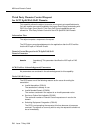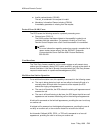
ASAI and Domain Control
5-10 Issue 7 May 1998
Third Party Answer
This capability allows the adjunct to request, on behalf of a station user, that a
ringing, bridged, or held call that is present at a station be “answered.” This is
done by connecting a call by forcing the station off-hook, if the user is on-hook, or
by cutting through the call to the head or handset, if the user is off-hook (listening
to dial tone or being in the off-hook idle state). The effect is as if the station user
selected the call appearance of the alerting, bridged, or held call and went
off-hook.
Information Flow
The adjunct expects a response to its request.
The Third Party Answer request is acknowledged (ACK) by the ECS if the ECS is
able to connect the specified call by either forcing the station off-hook (turning the
speakerphone on) or waiting up to five seconds for the user to become off-hook.
Third Party Answer Parameters
ACK (Positive Acknowledgement) Parameters
No parameters are contained in the acknowledgement for this capability.
Denial (NAK) Causes
The ECS issues one of the following reasons as the cause for ending the
association:
■ Invalid Association (CS0/81)
The association does not exist.
■ User Busy (CS0/17)
The station is busy on a call or there are no idle call appearances available.
■ No User Responding (CS0/18)
The station user did not go off-hook within five seconds and is not capable
of being forced off-hook.
■ Message Not Compatible with Call State (CS0/98)
The specified call at the station is not in the alerting, bridged, held state or
active state.
■ Resources not available (CS3/40)
The host attempted to add a seventh party to a call with six parties active
(bridging and held cases only).
call_id [mandatory] Indicates the alerting, bridged, or held call that
must be connected at the controlled station.


















